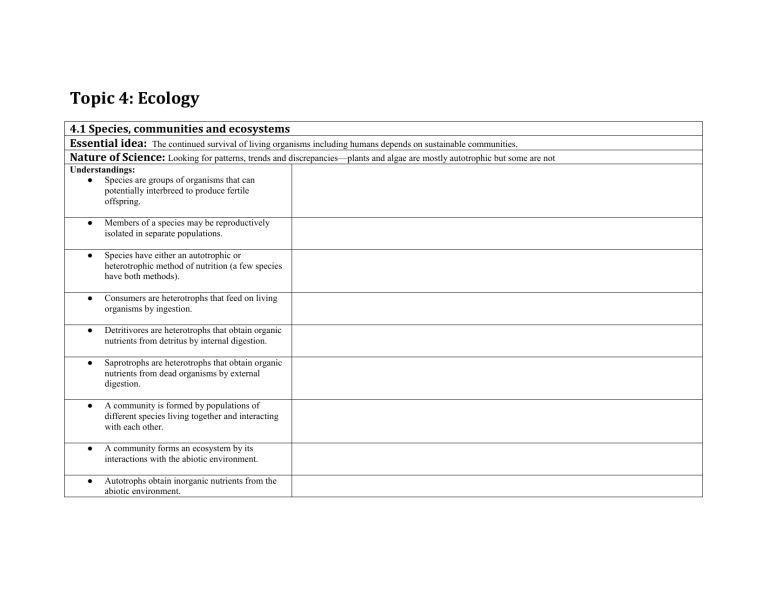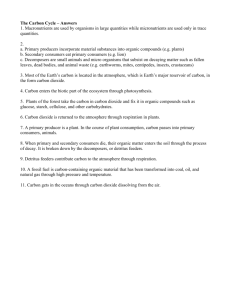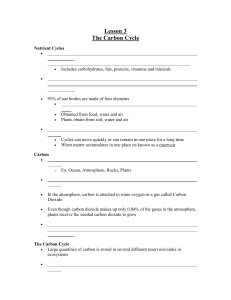Ecology: Species, Energy, Carbon, Climate Change
advertisement

Topic 4: Ecology 4.1 Species, communities and ecosystems Essential idea: The continued survival of living organisms including humans depends on sustainable communities. Nature of Science: Looking for patterns, trends and discrepancies—plants and algae are mostly autotrophic but some are not Understandings: ● Species are groups of organisms that can potentially interbreed to produce fertile offspring. ● Members of a species may be reproductively isolated in separate populations. ● Species have either an autotrophic or heterotrophic method of nutrition (a few species have both methods). ● Consumers are heterotrophs that feed on living organisms by ingestion. ● Detritivores are heterotrophs that obtain organic nutrients from detritus by internal digestion. ● Saprotrophs are heterotrophs that obtain organic nutrients from dead organisms by external digestion. ● A community is formed by populations of different species living together and interacting with each other. ● A community forms an ecosystem by its interactions with the abiotic environment. ● Autotrophs obtain inorganic nutrients from the abiotic environment. ● The supply of inorganic nutrients is maintained by nutrient cycling. ● Ecosystems have the potential to be sustainable over long periods of time. 4.2 Energy flow Essential idea: Ecosystems require a continuous supply of energy to fuel life processes and to replace energy lost as heat. Nature of Science: Use theories to explain natural phenomena—the concept of energy flow explains the limited length of food chains Understandings: ● Most ecosystems rely on a supply of energy from sunlight. ● Light energy is converted to chemical energy in carbon compounds by photosynthesis. ● Chemical energy in carbon compounds flows through food chains by means of feeding. ● Energy released from carbon compounds by respiration is used in living organisms and converted to heat. ● Living organisms cannot convert heat to other forms of energy. ● Heat is lost from ecosystems. ● Energy losses between trophic levels restrict the length of food chains and the biomass of higher trophic levels. 4.3 Carbon Cycling Essential idea: Continued availability of carbon in ecosystems depends on carbon cycling. Nature of Science: Making accurate, quantitative measurements—it is important to obtain reliable data on the concentration of carbon dioxide and methane in the atmosphere Understandings: ● Autotrophs convert carbon dioxide into carbohydrates and other carbon compounds. ● In aquatic ecosystems carbon is present as dissolved carbon dioxide and hydrogen carbonate ions. ● Carbon dioxide diffuses from the atmosphere or water into autotrophs. ● Carbon dioxide is produced by respiration and diffuses out of organisms into water or the atmosphere. ● Methane is produced from organic matter in anaerobic conditions by methanogenic archaeans and some diffuses into the atmosphere or accumulates in the ground. ● Methane is oxidized to carbon dioxide and water in the atmosphere. ● Peat forms when organic matter is not fully decomposed because of acidic and/or anaerobic conditions in waterlogged soils. ● Partially decomposed organic matter from past geological eras was converted either into coal or into oil and gas that accumulate in porous rocks. ● Carbon dioxide is produced by the combustion of biomass and fossilized organic matter. ● Animals such as reef-building corals and mollusca have hard parts that are composed of calcium carbonate and can become fossilized in limestone. 4.4 Climate Change Essential idea: Concentrations of gases in the atmosphere affect climates experienced at the Earth’s surface. Nature of Science: Assessing claims—assessment of the claims that human activities are producing climate change. Understandings: ● Carbon dioxide and water vapour are the most significant greenhouse gases. ● Other gases including methane and nitrogen oxides have less impact. ● The impact of a gas depends on its ability to absorb long wave radiation as well as on its concentration in the atmosphere. ● The warmed Earth emits longer wavelength radiation (heat). ● Longer wave radiation is absorbed by greenhouse gases that retain the heat in the atmosphere. ● Global temperatures and climate patterns are influenced by concentrations of greenhouse gases. ● There is a correlation between rising atmospheric concentrations of carbon dioxide since the start of the industrial revolution 200 years ago and average global temperatures. ● Recent increases in atmospheric carbon dioxide are largely due to increases in the combustion of fossilized organic matter.




